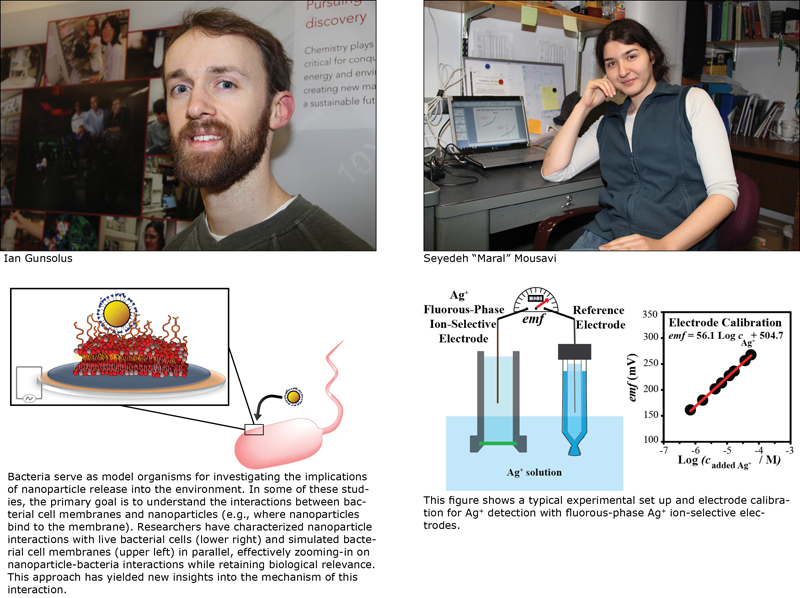

Main navigation | Main content
Research advances in the Department of Chemistry are led by outstanding graduate students, including Ian Gunsolus, a fourth-year graduate student working with Professor Christy Haynes, and Maral Mousavi, a fourth-year graduate student working with Professor Philippe Buhlmann.
Ian Gunsolus
Ian graduated with a bachelor’s degree in chemistry and mathematics from St. Olaf College. While at the University of Minnesota, he has earned a number of scholarships and fellowships, including the Robert L. Ferm Outstanding Graduate Teaching Assistant Award, a National Institutes of Health Biotechnology Training Grant, and the Minneapolis Torske Klubben Graduate Student Fellowship (twice).
He is broadly interested in analytical chemistry and in applying chemical principles to address environmental problems. His current research encompasses engineered nanomaterial interactions with biological systems, and their transformations in the environment. In collaboration with Professor Philippe Buhlmann’s research group, he has concurrently studied silver nanoparticle stability, dissolution, and toxicity to a bacterial cell model under aquatic environmental conditions. Bacteria are used throughout his research to understand the potential consequences of engineered nanomaterial release into natural environments, given their ubiquitous and fundamental role in natural ecosystems. In collaboration with other researchers within the Center for Sustainable Nanotechnology, an National Science Foundation-funded Center for Chemical Innovation, Ian studies the fundamental mechanisms of interaction between bacterial cell membranes and engineered nanomaterials, with the goal of informing the design of sustainable nanomaterials. In this context, he has also characterized the toxicity of emergent, industrially relevant classes of nanomaterials, such as those used in next-generation lithium-ion batteries.
For the future, Ian would like to pursue a career in an industrial research setting.
Seyedeh “Maral” Mousavi
Maral Mousavi earned her bachelor’s degree from Sharif University of Technology, one of the top universities in Tehran, Iran. She then came to the University of Minnesota in January 2011 to pursue graduate studies and joined the research group of Professor Philippe Buhlmann. She has received several prestigious awards and fellowships, including the 2014-15 Doctoral Dissertation Fellowship for outstanding research, the 2013-2014 Graham N. Gleysteen Fellowship for Academic Excellence in Chemistry, the 2014 Eastern Analytical Symposium Graduate Student Research Award for outstanding research achievements in the field of analytical chemistry, and the Graduate Student Travel Award from the Society for Electro-Analytical Chemistry to present research at the 2014 Pittsburgh Conference of Analytical Chemistry.
Maral works with electro-analytical sensors, specifically fluorous-phase, ion-selective electrodes (ISE), and is expanding the application of these sensors to environmental and biological samples. In collaboration with Professor Christy Haynes’ group, she utilized the Ag+ selective fluorous-phase ISEs to look at the challenging environmental issue of the toxicity of silver nanoparticles. She was able to quantify the extent and kinetics of Ag+ release from silver nanoparticles and also fully characterized Ag+ speciation in complex biological and environmental samples. Her work showed several advantages of detection with fluorous-phase Ag+ ISEs over the conventional methods used for studying silver nanoparticle toxicity. To make detection with fluorous-phase ISEs more applicable, Maral is determined to reduce the sample volume needed for detection with these sensors. For this purpose, she has been working on the design and synthesis of highly fluorophilic electrolytes that can be added to the fluorous membrane to reduce the membrane resistivity and allow fabrication of fluorous-phase micro-ISEs. In addition to fluorous-phase ISEs, she also investigated applications of nanoporous polymeric materials for the development of miniaturized and more robust reference electrodes, and worked on tuning the structure of electrolytes and ionic liquids to improve their electrochemical stability, increasing the energy density of electrochemical supercapacitors.
Maral enjoys how collaborative research can result in creative solutions for real life problems, and the opportunities available in the Department of Chemistry to work on exciting and challenging problems in collaboration with Professor Haynes, Professor Andreas Stein, and Professor Marc Hillmyer’s research groups. In the future, Maral wants to continue research in an industrial setting. Her goal and dream is to pursue scientific research and service that contributes to promoting health, education, and peace across the world.
